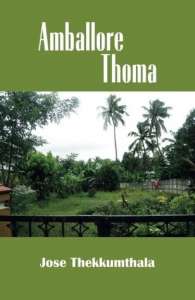
Thoma and his wife Ann have a hard life, and many, many children, in a world that is also fantastically surreal. In Amballore Thoma by Jose Thekkumthala, fabulism twines with magic realism and surrealism as the poverty-stricken family meets werewolves, Chicken Little, Old Man Monsoon, an eight-armed woman, and more.
Throughout it all, the family’s talking fortune-telling parrot serves as the family conscience and clown. People come back from the dead in disguise, children eat each other, and each event moves as seamlessly as a description of Thoma’s spitting habits or the shape of the family’s apartment. Each chapter in the novel reads as a kind of short story, with each story continuing the same saga.
Styled as fable, Thekkumthala uses prose to tell a tale rather than set a scene. The sparse descriptions support the story’s overall design – usually the only breaks in the prose emphasize the notes of magical realism within the overarching fabulist style, and they work exceptionally well. Although the novel is very wordy, it isn’t difficult to understand, and it’s a fairly smooth read, given the book’s creative construction.
Though there is some peril in crafting a story that takes this many liberties with realism, Amballore Thoma is in turns whimsical and powerful, specifically because it weighs down the natural absurdity of surrealism with heavy notes of reality. Real characters face real problems: Thoma is an alcoholic who beats his wife. His children fight, bicker, and hurt the family. There is rape, assault, and attacks from wild animals. Characters also deal with India’s changing political climate and the difficulties of emigration. So despite the light tone the fabulist style suggests, the pain and loss in the story hit hard, and the novel does a fantastic job of blending lesser-known literary genres to create a world we can recognize clearly as our own.
There are several places where Thekkumthala focuses on a cultural detail that doesn’t entirely need elucidation. An unnecessary note about how the “wood-burning stove” is a “clay oven” offers a good example. Either description would work, and the distinction doesn’t add anything to the narrative. Towards the end of the novel, Thekkumthala explains that nose rings are popular in India, when a number of characters had nose rings earlier in the story, so again the extra detail is unnecessary. There are also a number of dropped or misused words and sentences that need reworking: “He breathed life into their lives, giving them decent lives.” None of these minor issues seriously detract from the book’s flow, but they do need to be addressed.
These issues aside, Amballore Thoma is a great read for fans of magical realism, fabulism, or surrealism. The book would also be a great fit for cultural studies and discussion groups, as this is such a singularly unique take on Indian life. Due to the mature content of the book, it’s best suited to adult readers, as there are some explicit scenes and serious topics that are not suitable for younger readers, but for a discerning reader this is an enriching, amusing, and thought-provoking novel.
Links
Facebook
Amazon
Goodreads
STAR RATING
Design
Content
Editing
Get an Editorial Review | Get Amazon Sales & Reviews | Get Edited | Get Beta Readers | Enter the SPR Book Awards | Other Marketing Services























Leave A Comment